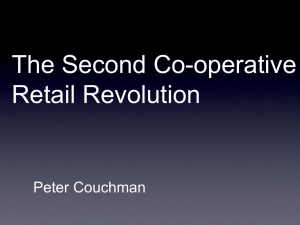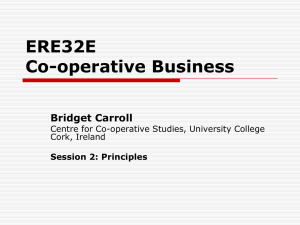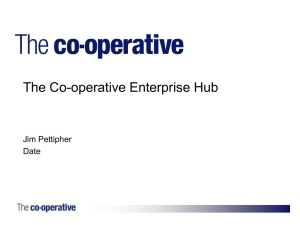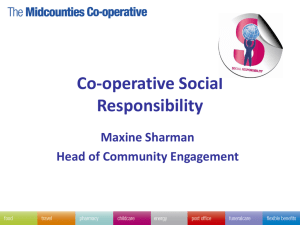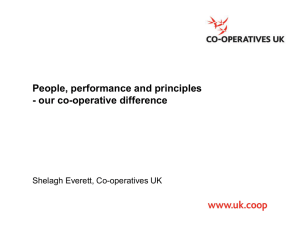INTERNATIONAL Route des Morillons 15 Tel: (41 22) 929 88 88 CO
advertisement
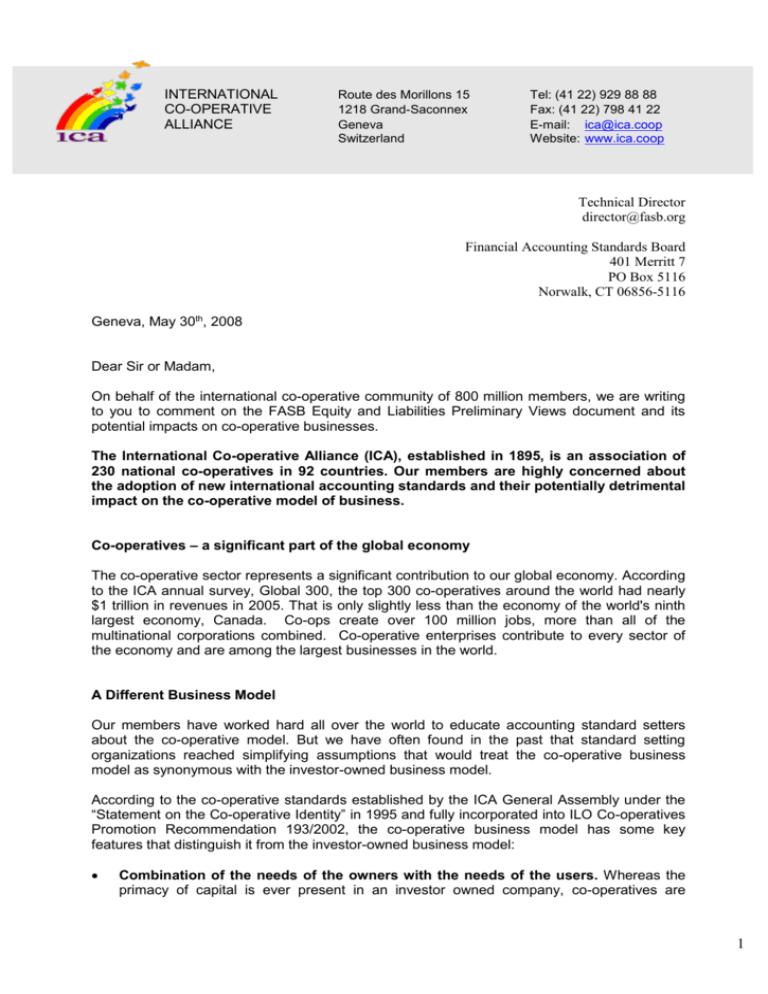
INTERNATIONAL CO-OPERATIVE ALLIANCE Route des Morillons 15 1218 Grand-Saconnex Geneva Switzerland Tel: (41 22) 929 88 88 Fax: (41 22) 798 41 22 E-mail: ica@ica.coop Website: www.ica.coop Technical Director director@fasb.org Financial Accounting Standards Board 401 Merritt 7 PO Box 5116 Norwalk, CT 06856-5116 Geneva, May 30th, 2008 Dear Sir or Madam, On behalf of the international co-operative community of 800 million members, we are writing to you to comment on the FASB Equity and Liabilities Preliminary Views document and its potential impacts on co-operative businesses. The International Co-operative Alliance (ICA), established in 1895, is an association of 230 national co-operatives in 92 countries. Our members are highly concerned about the adoption of new international accounting standards and their potentially detrimental impact on the co-operative model of business. Co-operatives – a significant part of the global economy The co-operative sector represents a significant contribution to our global economy. According to the ICA annual survey, Global 300, the top 300 co-operatives around the world had nearly $1 trillion in revenues in 2005. That is only slightly less than the economy of the world's ninth largest economy, Canada. Co-ops create over 100 million jobs, more than all of the multinational corporations combined. Co-operative enterprises contribute to every sector of the economy and are among the largest businesses in the world. A Different Business Model Our members have worked hard all over the world to educate accounting standard setters about the co-operative model. But we have often found in the past that standard setting organizations reached simplifying assumptions that would treat the co-operative business model as synonymous with the investor-owned business model. According to the co-operative standards established by the ICA General Assembly under the “Statement on the Co-operative Identity” in 1995 and fully incorporated into ILO Co-operatives Promotion Recommendation 193/2002, the co-operative business model has some key features that distinguish it from the investor-owned business model: Combination of the needs of the owners with the needs of the users. Whereas the primacy of capital is ever present in an investor owned company, co-operatives are 1 formed to address the specific needs of their members. In co-operatives, the interests of the members or users of the products and services are aligned with the owners of the cooperative. In an investor owned company, the shareholder’s interest is not typically aligned with the consumer’s. Profit making but not profit oriented. Co-operatives typically generate earnings and offer their membership a return of capital whereas investor-owned companies have shareholders to pay and must generate a profit in excess of the earnings to ensure a return on capital for investors. One member one vote. In a co-operative, the voting rights are not based on the amount of investment, as in investor owned companies, but rely on the one member, one vote principle, creating equal voting rights for each member. In investor owned companies, the more money you invest, the higher your returns. But in co-operatives, the “return” is often focused on your patronage or use of the co-operative. Many co-operatives remunerate their members by paying a patronage dividend, which represents an adjustment, aimed to compensate the members for what they paid in excess or received less in their transactions with the co-operative. The main characteristics of co-operative member shares As co-operatives are member-owned businesses, their equity is provided by their members. A co-operative member will make an equity investment, often nominal, in a co-operative upon becoming a member. This investment represents a member’s ownership interest in the cooperative. Although co-operative legislations can be very different from one country to another, cooperative member shares have common characteristics. Member shares are recognized by members as risk capital. In the unfortunate incidence of a bankruptcy, member shares participate in losses if the co-operative’s own funds (which are usually comprised of retained earnings) cannot cover the losses. In most cases, there is no active market for co-operative shares. The member’s interest is generally not transferable and shares can only be exchanged with the co-operative itself. Unlike publicly held investor-owned entities, an individual or business typically can join a cooperative only after meeting the requirements for membership and after approval of the Board of Directors, or in some cases, the membership. Co-operatives have a variety of arrangements regarding the redemption of members’ shares: in some countries or sectors, co-operative boards of directors have the unconditional right to refuse the redemption of the members’ shares, in other countries or sectors, the co-operative has an obligation to redeem the members’ shares when a member decides to withdraw from the co-operative or when he is excluded from the co-operative. Some co-operatives repurchase the shares of members upon their withdrawal from the cooperative, upon death, upon reaching retirement or a certain age. Other co-operatives have a policy of revolving equity of the co-operative over a period of time once specific equity levels are achieved or if the financial condition of the co-operative allows it. 2 Impact on Co-operatives – Why Is the Classification of Risk Capital as Equity Important: Publicly traded, investor owned companies are valued every day through the public market, which provides the price the market is willing to pay for their shares. The market fluctuates for a variety of reasons, many of which are not related to the value of the company itself. Analysts do not rely solely on the market and must use a variety of factors to determine the value and profitability of the company. Co-operative shares typically are not traded on the market and the value to a member or interested investor on any day depends on the relationship the member has with the cooperative. Users of co-operative financial statements fall into five categories -- potential members, vendors that wants to do business with the co-operative, potential outside investors, lenders and members. In each of these cases, the information the users would need would include the amount of equity held by the co-operative. Potential member: When small businesses, farmers, workers or consumers decide whether to join a co-operative, one of their criteria will be its financial status. This user wants to know if the co-operative can meet his or her needs in the marketplace, whether the co-op is sustainable and can meet earnings expectations. The equity side of the balance sheet is essential to make those decisions. Vendor: Vendors, many of which may be quite small, rely on financial information to determine whether the co-operative can meet its obligations. Many of the vendors may not be familiar with co-operatives and may view the lack of equity negatively. Potential outside investor: We have heard from many co-operatives that they face challenges in describing the way in which capital is held and distributed by co-operatives to potential investors. This task would be made that much more difficult if co-operative equity was reclassified. Lender: Many co-operative’s lenders require the co-operative to meet certain covenants which may include ratio requirements such as Times Interest Earned Ratio etc. Additionally, lenders may require a co-operative to maintain a certain minimum level of equity. Also, rating agencies typically consider the equity level of a co-operative to be an important characteristic of the ratings process. Co-operative members: Current members have an obvious need for information about the equity in their co-op. They may not only want to see the value of their ownership interest but information to assess whether the co-operative is financially sound and well-managed. 3 The Basic Ownership Approach Applied to Co-operatives It is not very clear today whether the Basic Ownership Approach is an acceptable approach for all co-operatives at the international level: some issues have yet to be resolved, particularly a clarification of the “ownership criterion” of the basic ownership approach (18.B), which could classify many co-operative shares as liabilities. Most co-operative member shares meet the “subordination criterion” of the basic ownership approach (18.A)1, because co-operative shares are generally the most subordinated interest in a cooperative and do not have priority over any other claim upon liquidation. The “ownership criterion” of the basic ownership approach (18.B)2, is more problematic or less universal: it is fulfilled by some co-operatives, particularly American co-operatives, but it is not clearly fulfilled, in its present drafting, by other co-operatives at the international level. Indeed, many co-operatives have specific laws or rules which forbid them to redeem their shares, upon or before liquidation, above their nominal value. As a consequence, even though the co-operative members holding co-operative shares: - are “entitled to a percentage of the assets of the entity that remain after all higher priority claims have been satisfied”, - are entitled to a share of the co-operative assets which depends on their share of the total claims with the lowest priority, - can lose 100% of their share value (no lower limit), those shares could nevertheless be accounted for as liabilities under the current formulation of criterion 18.B. Indeed, there is an upper limit to the members’ rights to the co-operative net assets, which is usually the nominal value of the co-operative member shares. Criterion 18.B seems to exclude these shares from the definition of Basic ownership instruments, which seems inappropriate as these instruments are in the most subordinate category of instruments and participate in potential losses. We urge FASB to consider that these instruments, which represent the most subordinated interest of the entity and are entitled to a percentage of the assets of the entity with no lower limit but with an upper limit, which is usually the nominal value of the instrument, should be defined as equity and not as liabilities. 1 The holder has a claim to a share of the assets of the entity that would have no priority over any other claims if the issuer were to liquidate on the date the classification decision is being made; 2 The holder is entitled to a percentage of the assets of the entity that remain after all higher priority claims have been satisfied. The holder‘s share depends on its share of the total claims with the lowest priority and has no upper or lower limit except for the amount of assets available. 4 Redeemable Basic Ownership instruments As stated previously, co-operatives have a variety of arrangements regarding the redemption of members’ shares: in some countries or sectors, co-operative boards of directors have the unconditional right to refuse the redemption of the members’ shares, in other countries or sectors, the co-operative has an obligation to redeem the members’ shares when a member decides to withdraw from the co-operative or when he is excluded from the co-operative. As a consequence, while some co-operative member shares may be considered puttable instruments, redeemable at the option of the co-operative member, many are not, where the co-operative has an unconditional right to refuse redemption. Where co-operative shares are neither mandatorily redeemable nor puttable, they should fall under the criteria of paragraph 18. But if they are mandatorily redeemable or redeemable at the option of the holder, they fall under paragraph 20 and would have to fulfil the following criteria to be accounted for as equity: 20.A The redemption amount is the same as the share of the issuer‘s net assets to which the holder would be entitled if it were to liquidate on the classification date; 20.B The terms of the instrument prohibit redemption if redemption would impair the claims of any instruments with higher priority than other basic ownership instruments. 21.A. The redemption formula is designed to approximate fair value of the instrument or the share of assets to which the holder would be entitled; 21.B. There is no active market for the instrument or the instrument can be exchanged only with the reporting entity. If most co-operative member shares fulfil criteria 20.B and 21.B, many of them would not fulfil criteria 20.A and 21.A. Indeed, the redemption amount of cooperative member shares in many countries is limited to their nominal value, which is not always equivalent to the share of the co-operative’s net assets to which the member would be entitled at liquidation. However, in some cooperatives, in which the members are entitled to the nominal value of their shares before and at liquidation, the criteria 20 A. and 21 A. would be satisfied. In many countries, upon liquidation or dissolution of the co-operative, the remaining net assets after the redemption of member shares at nominal value are contributed to a co-operative fund or other charitable entity. Since laws in various countries dictate that co-operatives direct these net assets to various funds at liquidation and the assets are otherwise owned by members, our position is that those shares should be treated as equity. We urge FASB: - to confirm that financial instruments that are neither mandatorily redeemable nor puttable should be accounted for as equity when they meet the criteria of paragraph 18 - to allow financial instruments that are redeemable at book value to be accounted for as equity when they represent the most subordinate interest of an entity, even if they don’t give an individual right on the remaining net assets in case of liquidation 5 Alternatives for FASB to Consider We urge FASB to consider alternative approaches that may more easily accommodate different business structures and yet allow FASB to achieve its goal of using a uniform approach for all types of entities. The Loss Absorption Approach The EFRAG « Loss absorption approach” holds promise not only for cooperatives but for all businesses that operate with at risk capital. This approach defines capital that has the potential to cover losses from a creditor’s perspective as equity. The basic idea of the “Loss absorption approach” takes into consideration both investors’ interests and the concerns of non-listed companies, in particular co-operatives. This approach provides a broader range of users with decision-useful information concerning entities in different legal forms across different jurisdictions. The “Loss absorption approach” would also appear to be consistent with a principles-based approach -- the principle being that capital available to absorb losses is ownership capital – and it is simple. This approach has potential appeal to cooperatives around the globe because member shares would be classified as equity regardless of any other consideration (redemption conditions, claims on the net assets at liquidation,…). The examples cited above would be classified as equity under the loss absorption approach whereas they may not be under the basic ownership approach. This would include situations where members have a limited claim on the residual assets in the event of liquidation. We urge FASB to consider this alternative approach very carefully, as it is principlesbased, simple and economically sound. The IFRIC 2 Approach IFRIC was passed to ensure that IAS 32 would continue to classify most co-operatives shares as equity. Under IFRIC 2, co-operative member shares are accounted for as equity as long as the co-operative has an unconditional right to refuse their redemption. The international co-operative community rallied and made significant compromises to comply with IFRIC 2. Indeed, for many co-operatives, IFRIC 2 forced some changes in their national or regional laws, bylaws and structure of their organization. IFRIC 2 has been in place and working for many cooperative financial institutions for more than 2 years. This approach accommodates the cooperative business model in many countries, though it does not everywhere as some national laws state that co-operatives have an obligation to redeem their member shares at the option of the holders. We urge FASB to at least ensure that no shares considered equity today under IFRIC 2 would be declassified into liability as the result of any future changes to the equity classification. 6 Though co-operatives function differently around the globe, their basic structure is similar and needs to be recognized by relevant accounting standards. We hope that any approach ultimately adopted by FASB will lead to a classification of cooperative member shares as equity. We look forward to working with FASB to ensure that international accounting standards take into account the needs of the international co-operative community. Yours sincerely, Ivano Barberini President 7
